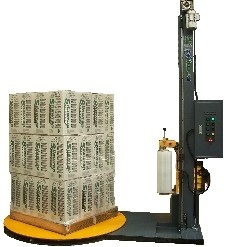Pallet wrapping machinery
Pallet wrapping machines are used extensively in most modern day manufacturing and distribution environments, they perform a key task that would otherwise require manual labour to complete. They are primarily designed to reduce packaging costs by reducing the amount of packaging used on products, reducing the amount of wasted packaging and reducing the labour costs involved in the process.
What to look for when buying a pallet wrapper

When looking to purchase a pallet wrapper you are going to want to make sure it will be suitable for your product, take dimensions of your pallets and how high the product will be stacked to make sure that the machine can fully wrap the product. You are also going to need to be sure that the quality of wrapping material that the machine applies is sufficient to protect your product, otherwise the whole operation becomes pointless.
You should discuss your production throughput with the supplier of the pallet wrapper to make sure that the machine will be capable of keeping up. If you are producing 5 pallets worth of product every minute but the pallet wrapper is only capable of wrapping 3 pallets a minute you are going to end up with a back log in production, which could end up being very costly.
When deciding between a semi or fully automatic machine you are going to need to weigh up the cost difference between the two types against how much money you stand to save by removing manual labour.
You should discuss your production throughput with the supplier of the pallet wrapper to make sure that the machine will be capable of keeping up. If you are producing 5 pallets worth of product every minute but the pallet wrapper is only capable of wrapping 3 pallets a minute you are going to end up with a back log in production, which could end up being very costly.
When deciding between a semi or fully automatic machine you are going to need to weigh up the cost difference between the two types against how much money you stand to save by removing manual labour.
How do pallet wrappers work?
Pallet wrapping machines work by wrapping a flexible packaging material, (usually plastic film but other materials can be used), around a product or collection of products usually stacked on a pallet.
Semi-automatic pallet wrapping machines represent the lower price level for many applications and for many companies, these machines usually work by having the load placed on to the wrapper turntable by a pallet truck or forklift and having the stretch film attached to it. An operator then starts the machine and the wrapping process begins. When the pallet has been sufficiently wrapped the operator simply cuts the film and removes the freshly wrapped load. Fully automatic machines remove the need for manual intervention thus reducing labour costs involved in the process.
Semi-automatic pallet wrapping machines represent the lower price level for many applications and for many companies, these machines usually work by having the load placed on to the wrapper turntable by a pallet truck or forklift and having the stretch film attached to it. An operator then starts the machine and the wrapping process begins. When the pallet has been sufficiently wrapped the operator simply cuts the film and removes the freshly wrapped load. Fully automatic machines remove the need for manual intervention thus reducing labour costs involved in the process.
